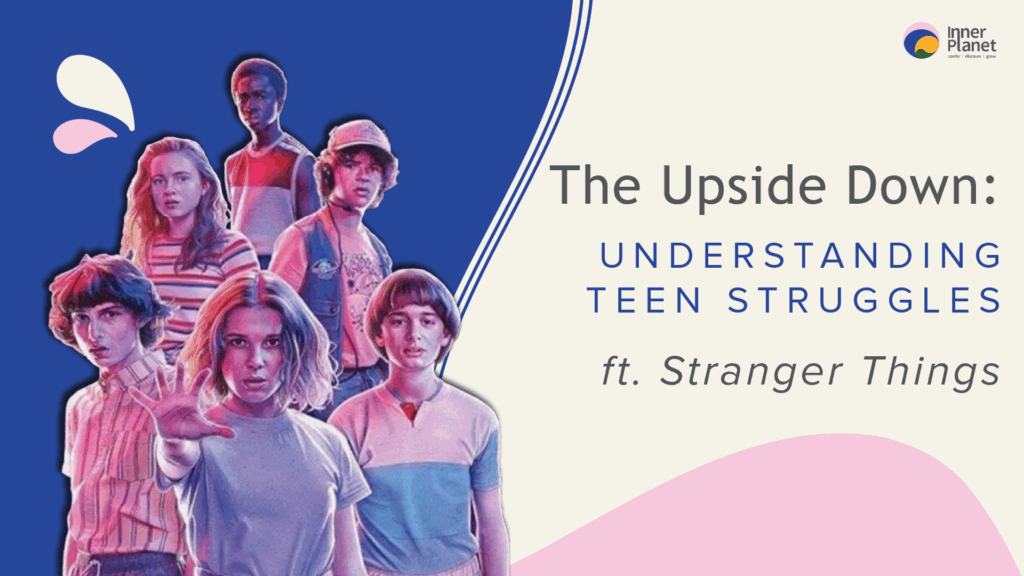Adolescence is a strange, stormy stretch of life. It’s the messy middle between childhood and adulthood, full of contradictions, insecurity, chaos, and emotional upheaval. In Stranger Things, this phase is brought to life through the Upside Down – a shadowy mirror-world that twists the familiar into something eerie and unsettling. Just like the show’s characters, teens can feel like they’ve fallen into a world where nothing feels quite right.
Each character in Stranger Things reflects a different challenge young minds face. From trauma and grief to friendship and self-doubt, their stories help us understand what adolescence feels like on the inside. So let’s explore some of those journeys using a psychological lens, showing how growing up is more than just getting older. It’s about facing inner fears, finding your people, and slowly learning who you are.
Eleven and the Cost of Childhood Trauma
Eleven’s past is filled with loneliness, pain and loss. Taken from her mother at birth and raised in a lab, she didn’t get the love and care most children need. Psychologists call this a disruption in attachment – when a child doesn’t have a steady, loving caregiver, it can make it hard to feel safe or know who you are (Briere & Lanktree, 2013).
As Eleven becomes a teenager, she struggles to understand herself. Is she a “monster” or a hero? “Jane” or “Eleven”? This confusion is part of a normal identity crisis that many teens go through, as described in Erikson’s theory of identity formation (Erikson, 1994; Truskauskaite-Kuneviciene et al., 2020). But for Eleven, it’s much harder because of her traumatic past. Still, the love she finds – from Hopper, Mike, and even her friends – helps her begin to heal. With their support, she starts to build a new sense of self and learns she’s more than what happened to her.
The Power of Friendship
In the strange affairs of adolescence, friends can be your lifeline. Mike, Dustin, Lucas, and Will form a tight group that gives each other acceptance, support, and strength. Their friendship helps them face both real and emotional monsters.
Research suggests that teens learn a lot about themselves through their peers. They figure out values, boundaries, and identity by spending time with friends (Erikson, 1994). In Stranger Things, the Party does just that. They help Eleven learn to trust, support Will through his trauma, and stay loyal to each other. This kind of connection is proven to help teens feel less alone and more emotionally balanced (Letkiewicz et al., 2023; Teen Mental Health and Therapy Benefits, n.d.). It’s no wonder their motto is: “Friends don’t lie.”
Will Byers and the Long Shadow of Trauma
Will Byers is soft-spoken and sensitive. After he’s taken into the Upside Down, he comes back changed. He suffers from flashbacks, panic attacks, and moments where he seems completely disconnected. This is called dissociation – a way the mind protects itself when things get too overwhelming (Boyer et al., 2022).
Even when surrounded by people who care, Will feels invisible. He doesn’t talk much about what happened, maybe because he thinks no one will understand. This is something many psychological trauma survivors feel – as if their pain sets them apart (Webb, 2014; How Feeling Invisible Impacts Your Mental Health, 2025). But Joyce, his mum, never gives up on him. She keeps reminding him that he matters.
What we see in Will is a quiet kind of resilience. It’s not loud or dramatic, but it shows up in the small moments — when he chooses to stay connected, even as part of him wants to disappear. His journey is a reminder that healing from trauma isn’t about erasing the past, but about learning to live with it, and still choosing connection. Research shows that simply being seen and validated can start this process (Webb, 2014; How Feeling Invisible Impacts Your Mental Health, 2025). For teens who feel lost or overlooked, Will’s story is powerful: it tells us that healing starts not with grand gestures, but with someone gently saying, “I see you. You matter.”
Max and Grief
Losing someone you love as a teen can feel like being caught in a storm. After Billy (her elder sibling) dies, Max pulls away from everyone. She listens to music on repeat because it’s the only thing that gives her peace. This isn’t just fiction. Music really does help teens manage big emotions. It helps them make sense of sadness and feel in control (Botello, 2023; Chen, 2023).
Max acts out in risky ways and keeps her feelings bottled up. That’s common in grieving teens, who may not have the words for what they’re going through (Gómez, 2023). But slowly, she begins to open up – reading the letter, talking to Lucas, and remembering Billy in better times. These actions are small yet powerful ways of mental health care. They’re ways of processing grief and finding a path back to hope (Entwistle, 2023; Crone, 2024).
Vecna as the Inner Critic
Vecna isn’t just a villain – he’s a voice. He represents the harsh thoughts many teens have inside their heads. Thoughts like “I’m not good enough,” or “It’s all my fault.” Psychologists call this the inner critic – and it can grow louder after trauma or bullying (Inner Critic, 2025).
When Vecna targets characters in the show, it’s because they’re already carrying shame, jealousy, or guilt. The same happens in real life: when you feel hopeless or alone, those inner voices can take over. Research shows that self-criticism is linked to depression and even suicidal thoughts in young people (Boostani, 2025).
But Stranger Things offers more than fear—it offers a way through. The group doesn’t just fight a monster – they fight the thoughts that try to convince them they’re unworthy. Standing together, they resist Vecna’s grip with music, memory, and connection. It’s not just about magic or superpowers – it’s about choosing not to give in to the darkness inside.
And that’s a powerful reminder for real life too: even when your thoughts feel overwhelming, you are not alone. There’s always a way through the dark—especially when you let others walk with you. You are not the voice that hurts you. And there is hope, even in the heaviest moments.
Growing Out of the Upside Down
Stranger Things may be dark, but it’s also a story about healing. Most people, even after trauma, find ways to bounce back – this is what psychologists call resilience (Post-traumatic growth, 2025). What helps? Strong relationships, being able to name your emotions, and finding a sense of purpose (Post-traumatic growth, 2025).
Saying what you feel – like “I’m scared” or “I miss you” – actually helps calm your brain. It takes the edge off emotional pain (Putting Feelings Into Words, 2007). Characters like Max and Will begin to feel better when they share what’s really going on. And Eleven shows us how turning pain into action – protecting others, telling her story – helps create meaning. That’s called post-traumatic growth: finding strength, not just despite hardship, but because of what you’ve been through (Post-traumatic growth, 2025). Professional therapists also help through this challenging time of unfamiliar changes
Adolescence can feel like the Upside Down – full of confusion, fear, and change. But with the right support, we can come out stronger, more self-aware, and more connected.
Growing up isn’t easy. It’s messy, emotional, and often misunderstood. But Stranger Things reminds us that even in the darkest times, there’s a path forward. With care, honesty, and connection, we can move from fear to understanding, from pain to purpose.
And just like Hopper told Eleven: keep the door open – even just three inches. Sometimes, that’s all it takes for the light to come in.
If you need help on the journey of self-discovery and growth, we’re always just a call away!
References
- Adolescent development and participation. (2025, June 30). UNICEF India. https://www.unicef.org/india/what-we-do/adolescent-development-participation
- Amen Clinics. (2025, February 26). How feeling invisible impacts your mental health. https://www.amenclinics.com/blog/how-feeling-invisible-impacts-your-mental-health/
- Boostani, H., Rostami, H., Toulabi, M., & Mousavi Asl, E. (2025). The mediating role of shame and self-criticism in the relationship between early life experiences and suicidal ideation. Jundishapur Journal of Chronic Disease Care, 14(1), e157066. https://doi.org/10.5812/jjcdc-157066
- Botello, R. (2023, April 12). The harmful side of music: Understanding the effects of rumination on adolescent mental health. Manning Family Children’s Hospital, LCMC Health. https://www.manningchildrens.org/news-blog/2023/april/the-harmful-side-of-music-understanding-the-effe/
- Boyer, S. M., Caplan, J. E., & Edwards, L. K. (2022). Trauma-related dissociation and the dissociative disorders: Neglected symptoms with severe public-health consequences. Delaware Journal of Public Health, 8(2), 78–84. https://doi.org/10.32481/djph.2022.05.010
- Briere, J., & Lanktree, C. B. (2013). Interventions for identity issues. In Integrative treatment of complex trauma for adolescents (ITCT-A): A guide for the treatment of multiply-traumatized youth (2nd ed., pp. 103–107). USC Adolescent Trauma Treatment Training Center. https://keck2.usc.edu/adolescent-trauma-training-center/treatment-guide/chapter-12-interventions-for-identity-issues/
- Chen, L. (2023). Influence of music on the hearing and mental health of adolescents and countermeasures. Frontiers in Neuroscience, 17, 1236638. https://doi.org/10.3389/fnins.2023.1236638
- Crone, E. (2024, June 10). Music to our ears: How playing an instrument affects the adolescent brain. Universiteit Leiden. https://www.universiteitleiden.nl/en/news/2024/06/music-to-our-ears-how-playing-an-instrument-affects-the-adolescent-brain
- Donald, E. (2016, September 23). The kids are not all right: Stranger Things and the horror of puberty. Kill Your Darlings. https://www.killyourdarlings.com.au/2016/09/the-kids-are-not-all-right-stranger-things-and-the-horror-of-puberty/
- Entwistle, A. (2023). The rhythm of emotion: The use of music therapy to give voice to grieving children & adolescents [PowerPoint slides]. Four Seasons. https://cme.ahn.org/sites/default/files/course/2023-02/Entwistle_The%20Rhythm%20of%20Emotion_2023%20Grief%20Talks%20Slides.pdf
- Erikson, E. H. (1994). Identity and the life cycle. W. W. Norton & Company. https://childdevpsychology.yolasite.com/resources/theory%20of%20identity%20erikson.pdf
- Gómez, R. (2023, January 14). Characteristics of grief in adolescents: Identification and management. Mentes Abiertas Psicología. https://www.mentesabiertaspsicologia.com/blog-psicologia/characteristics-of-grief-in-adolescents-identification-and-management
- Inner critic. (2025, June 29). In Wikipedia. Retrieved July 1, 2025, from https://en.wikipedia.org/wiki/Inner_critic
- Letkiewicz, A. M., Li, L. Y., Hoffman, L. M. K., & Shankman, S. A. (2023). A prospective study of the relative contribution of adolescent peer support quantity and quality to depressive symptoms. Journal of Child Psychology and Psychiatry, 64(9), 1314–1323. https://doi.org/10.1111/jcpp.13813
- Post-traumatic growth. (2025, June 29). In Wikipedia. Retrieved July 1, 2025, from https://en.wikipedia.org/wiki/Post-traumatic_growth
- Rajkumar, E., Julia, G., & Sri Lakshmi, K. N. V. (2022). Prevalence of mental-health problems among rural adolescents in India: A systematic review and meta-analysis. Scientific Reports, 12, 16573. https://doi.org/10.1038/s41598-022-19731-2
- Senapati, R. E., Jena, S., Parida, J., … & Mohanty, A. K. (2024). The patterns, trends and major risk factors of suicide among Indian adolescents: A scoping review. BMC Psychiatry, 24, 35. https://doi.org/10.1186/s12888-023-05447-8
- Televero Health. (n.d.). Teen mental health and therapy benefits: What parents should know and what teens wish you knew. Retrieved July 1, 2025, from https://televerohealth.com/therapy-for-teens-what-parents-should-know-and-what-teens-wish-you-knew/
- Truskauskaite-Kuneviciene, I., Brailovskaia, J., Kamite, Y., Petrauskaite, G., Margraf, J., & Kazlauskas, E. (2020). Does trauma shape identity? Exploring the links between lifetime trauma exposure and identity status in emerging adulthood. Frontiers in Psychology, 11, 570644. https://doi.org/10.3389/fpsyg.2020.570644
- UCLA Health. (2007, June 21). Putting feelings into words produces therapeutic effects in the brain: UCLA neuroimaging study supports ancient Buddhist teachings. https://www.uclahealth.org/news/release/putting-feelings-into-words-produces-therapeutic-effects-in-the-brain-ucla-neuroimaging-study-supports-ancient-buddhist-teachings
- Webb, J. (2014, July 25). Invalidated child: Invisible adult. https://drjonicewebb.com/invalidated-child-invisible-adult/


